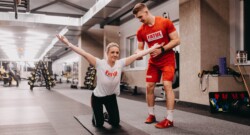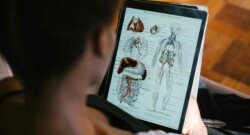Author: Tamara Mrázová
Movement therapist Oskar Fatul advises: Not every movement is healthy; only correct movement is healthy.
Did you know that there is a difference between physiotherapy and movement therapy? Movement therapy is a method that uses movement and physical activity to improve physical, emotional, and mental health. The work of a movement therapist is a true mission to help people who suffer from various movement difficulties that negatively affect the functioning of their daily lives. Oskar Fatul, an expert in movement therapy, has been working in this field for several years. He teaches people the correct way to move and explains how to properly work with our bodies. Also, he wrote the book “Life Without Pain Begins Here,” which is particularly suitable for parents with young children, as it helps optimize the positions their children adopt during development, whether they are resting positions or those involving movement. He is also the author of a digital rehabilitation course, through which one can obtain all the guidelines for treating various body pains. Oskar, what is the difference between physiotherapy and movement therapy? With a general physiotherapist, we essentially have the same goal. We try to help people eliminate pain and feel better. The average physiotherapist today focuses on which muscles are active, which muscles are weakened, and tries to manage the acute pain condition. For example, if you experience a sudden sharp pain or if pain suddenly starts shooting in various parts of your body. Movement therapy is based on improving the patient’s posture and changing habits and movement patterns to eliminate accumulated tension and pressure in the body. As for the movement therapist, I strive to show people in the Czech Republic and Slovakia how to optimize the way they move, which helps them eliminate the causes of their pain. What types of problems do you treat most frequently? I most often deal with issues related to the lower back or spine. Specifically, clients frequently have problems with the disc at the bottom of the lower back. Generally, I address problems that patients find unsolvable. Are your patients only athletes? Quite the opposite, I primarily focus on the general public, who unfortunately have the least information about proper movement. Even if they do have information, it’s not always entirely accurate. Additionally, due to the lifestyle we lead in today’s society, where we have to sit a lot at work, we encounter various problems, such as posture issues. What is the difference in treating men and women? To a large extent, it does not depend on gender but on the acuteness of the problem. However, it is true that women more often have problems with the thoracic and cervical spine, while men tend to suffer from lower back pain and issues in the lower part of the body. I also perceive a psychological difference. Women are more open to diagnosing and addressing the problem. They are willing to take care of their bodies and get them back in order. Men test how much pain they can endure and try to tough it out. They come to see me only when they feel very bad. Women are more open to diagnosing and addressing the problem. Men test how much pain they can endure and try to tough it out. How can an average person contribute to feeling better through proper movement? An average person should focus on the positions they put themselves into and pay attention to how they move. It is difficult to know what the right movement for us is, as no one has given us this information. From around the age of six, we sit at desks and, practically, continue sitting for the rest of our lives. In general, I usually recommend the following: When walking, point your feet forward. This will relieve your knees. Many people have their pelvis pushed forward and remain bent at the lower back. Shift your hip joints back so they are directly above your ankles. Breathe with your chest, not your stomach. Breathing into your chest will open up and stretch your body nicely. What to avoid: Do not stay in one static position for too long. Regularly move your spine and joints. If you are stiff, do not react abruptly. Not every movement is healthy; only the correct movement is healthy.
Nikola, as a Slovak, has been living in Spain for a few years now: “Spaniards live in the moment and don’t chase after everything like Slovaks do.”
Imagine waking up every day to the sound of flamenco guitars, with a view of the sun-drenched Mediterranean coast, and ordering a shrimp paella for lunch. This Spanish stereotype is something Slovak Nikola Noveková decided to experience firsthand when she moved to Spain to find work. But are these dreams as rosy as they seem? Nikola shares more about life in Spain in her article. Why did you decide to leave Slovakia? I’ve always dreamed of experiencing life abroad. At first, it was probably about the idea of “moving for a better life.” I’ve always been drawn to living outside of Slovakia, where I could feel happier and more alive—something I felt was lacking to some extent back home. Why Spain? The fact that I ended up moving to Spain was pure coincidence at this point. (laughs) I was working in Slovakia at an agency where I coordinated the Work and Travel USA program. In 2019, I participated in this program and experienced living abroad for the first time. I wanted to travel again to the USA in 2020 and 2021, but the pandemic situation prevented that. At that time, I had an intense urge to go somewhere for the summer, and I saw a post online that a company was looking for a fitness instructor for Mallorca. I thought to myself, this would be my dream job, especially since I’m a former dancer, I love yoga, and I’ve studied sports and dance. THAT’S HOW IT ALL STARTED. ALL OF A SUDDEN, ONE SUMMER TURNED INTO THREE YEARS. What is the biggest cultural difference between Spain and Slovakia? There are really a lot of differences. For example, meal times are quite distinct. People have breakfast around 11:00 AM, lunch is usually between 3:00 and 4:00 PM. Then, around 6:00 PM, they have what’s like our afternoon snack (called merienda), and dinner is typically around 10:00 PM, sometimes even later. The pace of life is also much slower, and people are generally very direct. They aren’t afraid to express their emotions openly, but they are also very friendly and communicative. Parties here have no age limit, so even my friends in their 30s and 32s go out to clubs anytime they like 🙂 You found love in Spain. What is it like to date outside your culture? Of course, there are differences, but we get along very well. At first, our paces were quite different, but at least I learned to slow down, because before that, I was always rushing around. Many Spaniards also don’t plan their future in detail. They don’t rush into marriage, having kids, or buying homes or apartments. When it happens, it happens 🙂 They live more in the present and don’t chase after everything like we do. They believe that everything will come in its own time. So, there’s usually no social pressure from society. To sum it up, my partner and I don’t really feel any extreme differences, but of course, it always depends on the people. THANKS TO MY PARTNER, I’VE LEARNED HOW TO SLOW DOWN. What would you recommend to those considering life in Spain? If you’re thinking about moving there long-term, I definitely recommend learning Spanish. You also need to have an open mind because life in Spain is different from what we’re used to, and the mentality of people is also different. There are different laws and rights, the healthcare system is different, and your lifestyle will change significantly. However, if you’re determined to move, like Spain, and are excited to try living here, I would wholeheartedly recommend it. Would you do it again? Do you regret any of it? I try to never regret anything that’s happened or my decisions. I admit I had a tough period in Spain, but I never thought about regretting my decision. On the contrary. Are you planning to get back to Slovakia? I can’t really answer that question yet, as I think about it mainly because I miss my family a lot. I would return for them. On the other hand, there’s still something keeping me here, and I’m not ready to leave. We’ll see. I’m like a Spaniard now, not planning too far into the future. I’m living in the present and will see what life brings 🙂 Spain has changed my life. It’s shown me that I’m capable of things I never believed I could do. I’ve had an amazing experience, changed my perspective on life, and learned a new language. If I could turn back time, I know I would do it again.
How to properly organize your time at work? A few tips to help you become more productive
Today’s fast-paced world often doesn’t give us a chance to stop and catch our breath. We spend our days overwhelmed with work and responsibilities, and time just slips away. One important step to incorporate into our daily routine is planning. If you’re looking for tips on how to manage your time effectively while working, you’re in the right place. By properly organizing our work schedule, we can save several valuable hours each week, which we can use to our advantage. Whether it’s improving our hobbies, spending active time with loved ones, or simply relaxing with a good book, finding a bit of time for ourselves always pays off. Eliminate distractions We’ve all been there. You sit down at your computer to get some work done, but staying focused becomes a challenge. Everything around you seems to distract you. Whether it’s the music playing in your office, chatting colleagues, or the noise of traffic outside, try to minimize these distractions. If necessary, use earplugs or put on headphones with calming music. White noise can help adults concentrate just as much as it helps babies fall asleep. Clean your desk Let’s stay on the topic of distractions for a bit longer. This time, it’s not just about noise, but visuals as well. Your workspace and the desk you work at play a crucial role. Remove anything that isn’t related to your work. Various decorations and unnecessary items can divert your attention away from the screen. Some studies suggest that the best desk is one that only has your laptop and essentials like a lamp, a planner, or a glass of water. Work in Proper Intervals During an eight-hour workday, it’s tough to keep our focus from drifting constantly. Try using interval methods. Simply given, alternate between periods of intense work and short breaks. For every half-hour of focused work, take a 5-minute break to relax and shift your attention elsewhere. This way, your brain will learn when to be fully engaged and when to relax. Your efficiency will increase significantly. The length of the work interval varies for each person, but it should never be less than 30 minutes. Plan your breaks. Value Feedback Reflect. Ask yourself: Did I work better than last month? If so, what helped me improve? If not, why, and where did I fall short? Seek feedback from those who motivate you. Whether it’s your boss, a client, or a colleague, ask them for their input. While recognizing our strengths is important, it’s also beneficial to see ourselves through someone else’s eyes from time to time. You might learn things about yourself that you wouldn’t have noticed otherwise, which can only make you stronger. If the feedback is negative, at least you’ll know what to work on in the future. Set milestones It’s really hard to work without motivation. That’s why it’s good to set small, manageable goals that will motivate you towards a bigger objective. Reward yourself. A great tip is to treat yourself to your morning coffee only after you’ve completed the most annoying task of the day. The same goes for your favorite sweets or the occasional lunch delivery you enjoy at work. Whether it’s small steps or something bigger, remember that we’re not machines. Life is meant to be lived, not just survived 🙂 EVEN WHEN WORKING, SURROUND YOURSELF WITH WHAT YOU LOVE. BE KIND TO YOURSELF!
5 unusual sports you probably haven’t heard of yet
Sports are a big part of our lives. After the pandemic, many of us realized how precious our active time can be. It’s often about staying in shape, keeping fit, or living a healthy lifestyle. Sports are also a key part of every culture. In this article, you’ll discover some unusual sports you might not know about, but which are totally normal in other parts of the world. Quidditch Remember the wizarding saga Harry Potter? Quidditch is the unique sport many of us associate with this film series. In the movies, we see wizards flying around the Quidditch pitch on broomsticks, trying to score by getting a ball through the opponent’s hoop. What many might not know is that this sport has made its way into the real world. Unfortunately, without the flying broomsticks 🙂 In Slovakia, Quidditch started being played in 2015, and there is now even an international competitive version. It’s a mixed-gender contact sport where both men and women participate. Each team consists of seven players who, as you might have guessed, run around the field with a broom between their legs. These aren’t traditional wooden brooms but flexible plastic replicas. Bossaball How about taking a trip to Brazil? That’s where the sport of bossaball took off, a unique blend of several globally known sports. In bossaball, you’ll find elements of soccer, gymnastics, and volleyball, all set to modern music. Bossaball is played on an inflatable court with a trampoline in the middle. Each side of the net has a team of three or two players. One player spends the game bouncing on the trampoline and spiking the ball, while the other two players handle passes and set up shots for the bouncer. Chessboxing If you thought no sport could surprise you with its absurdity, let us introduce you to chessboxing. Yes, this sport is exactly what its name suggests. A combination of chess and boxing, two of the most opposite sports you can imagine. Wondering about the game strategy? Players face off in short rounds lasting three minutes each. A round of chess alternates with a round of boxing. Would you try such a sport? Which extreme of this sport do you prefer? Joggling It turns out that combining different sports is a popular trend around the world. A great example is “joggling,” which combines jogging and juggling. That’s right, jogglers run on a track while juggling. Maybe they found plain running a bit too boring. Cheese rolling In the UK, they dive right in—literally! The annual Cheese Rolling Festival has been a tradition for years and is an incredible spectacle. Dozens of people first climb up a steep hill. Then, they release a wheel of cheese from the top. That’s when the fun begins. All the participants start chasing the cheese headlong down the hill. Calling it running is a bit of a stretch, given how steep the hill is. There are plenty of falls, tumbles, and rolling around. It’s probably no surprise to readers that 95% of the participants in this sport are men. They’re always fueled by adrenaline and, as is customary in England, some good English beer flowing through their veins 🙂
Have you heared of Camino de Santiago de Compostela?
Thousands of kilometres of paths, traveled by millions of pilgrims, all with the same goal—Santiago de Compostela. It’s one of the most famous pilgrimages in the world, leading all the way to the northwestern tip of Spain. Do you know what the Camino is? Have you heard about it? What exactly is the Camino de Santiago? The Camino de Santiago, also known as the Way of St. James, is a network of pilgrimage routes leading to the tomb of Saint James in the cathedral of Santiago de Compostela in northwestern Spain. This centuries-old pilgrimage path, stretching across Western Europe, attracts adventurers, spiritual seekers, and culture enthusiasts alike. This scenic route, known as “the Camino,” has a magnetic pull that draws pilgrims from all over the world. Pilgrims, known as “peregrinos” travel hundreds of kilometres each year, making their way to the city of Santiago in northern Spain. They carry backpacks with all their essentials. Beyond the physical challenge, the Camino represents a profound spiritual journey, offering participants a chance to connect with history, nature, and most importantly, themselves. There’s more than one There are several main pilgrimage routes that lead to Santiago. Camino Francés: The most popular route, approximately 780 kilometers long, starts in France and ends in Santiago de Compostela. Camino Portugués: This route starts in Portugal, usually from Lisbon or Porto, and is the second most popular route. Camino del Norte: A route that runs along the northern coast of Spain. Camino Primitivo: The oldest route, starting from Oviedo, and considered the most challenging due to its terrain. Via de la Plata (Silver Route): This route starts from Seville in southern Spain. How long does it take? The duration of the Camino de Santiago pilgrimage depends on various factors, such as the specific route chosen, the physical condition of the pilgrim, their walking pace, and the number of days planned for rest and sightseeing. Pilgrims also need to consider the weather, which can often extend and complicate the journey. The duration of each route is very individual. On average, however, the Camino takes about a month. One of the longest routes, the Via de la Plata (Silver Route), can take up to two months to complete. Not every pilgrim can afford to spend two months a year on this pilgrimage, so shorter routes, which have developed from the five main routes, have become popular. For example, the Camino Inglés (English Way) takes about a week to complete, while the Camino Finisterre requires only 5 days. Facts you might not have known about the Camino La concha (The Scallop Shell): The scallop shell of Saint James is the symbol of the pilgrim’s journey. Pilgrims follow these painted shells along their path, ensuring they stay on the right route. Los albergues: These are modest hostels where pilgrims stay overnight. Their daily route typically leads from one albergue to another, where they can wash their clothes if needed and spend the night in simple beds. Pilgrims do not expect luxury. Stamps: At the end of each day, pilgrims can find a place in the local church to receive a stamp for their journey. These stamps are collected in a travel diary, which they purchase at the start of their pilgrimage. UNESCO: Some Camino de Santiago routes are listed as UNESCO World Heritage Sites, including the French Way (Camino Francés) and the Northern Way (Camino del Norte). Compostela: This is the certificate that pilgrims receive after completing at least 100 kilometers on foot or 200 kilometers by bike to Santiago de Compostela. Crowds: In 2022, more than 400,000 pilgrims completed the journey. The Camino is gaining popularity each year, and it is estimated to attract even more tourists in the future. The journey is a unique personal experience for everyone, and pilgrims often speak of the spiritual or inner changes this path brings. Whether you embark on this journey alone or with loved ones, you will surely find what you are searching for. Or at least, discover how to achieve it. During the endless kilometers your feet will traverse, you’ll give your mind the perfect space for deep reflection. “HE WHO COMES TO THE CAMINO WITH A HEAVY HEART WILL LEAVE WITH A LIGHT SOUL.”
10 fascinating facts about human body
The human body and how it works is a fascinating web of systems that never fails to amaze scientists, doctors, and even those of us with just a little curiosity. From the incredibly complex brain to the constantly renewing skin, our bodies are full of wonders that we often take for granted. If you didn’t enjoy biology class in high school, don’t worry. Today, we’re sharing some of the coolest facts about our bodies that you might not know yet. 1.Brain Energy Consumption Our brain contains about 86 billion neurons, which is why it uses up to 20% of the body’s total energy. It’s no wonder they say everything starts in our head! 2.The Number of Bones Changes Throughout Our Lives Newborns have 270 bones at birth, many of which are made of cartilage. As we grow, some of these bones fuse together, so an adult has only 206 bones. 3.The Length of Our Blood Vessels If we connected all our blood vessels end to end, they would stretch for 97,000 kilometers. That’s about the same as traveling across Slovakia from east to west 195 times! 4.Unique Fingerprints Each one of us has unique fingerprints. No two sets are the same, not even in identical twins. Experts discovered this relatively recently, which is why fingerprints only started being used as a unique identification method by police in 1977. 5.The Strength of Our Tongue Would you believe it if someone told you that the human tongue is as strong as our thigh muscle? It’s true! Together, they make up the two strongest muscles in the body. 6.Bone Strength Not only muscles, but bones are incredibly strong and resilient too. A small bone, like one in the wrist, measuring around 5 centimetres, can bear up to 8 tons of weight. 7.Our Stomach is Acidic If you’ve ever wondered how our stomach processes the food we eat, it does so quite effectively. Stomach acid is so powerful that it can even dissolve metal. 8.We Have Incredible Capacity Most of us have experienced the tiring process of studying countless pages that we needed to memorize. If you ever feel like you can’t take in any more, remember this: the human memory can store about 2.5 petabytes of information, which is comparable to the capacity of the entire internet. 9.As Fast as a Sneeze Human sneezes can reach speeds of up to 160 kilometers per hour, and the droplets they disperse can travel up to 10 meters away from us. Masks and respirators during the pandemic really did a lot to protect us! 10.Our Calves Keep Us Upright If you thought our upright posture was thanks to our spine, you’d be mistaken. It’s actually quite incredible—our calf muscle is one of the strongest muscles in the body because it continuously works to keep us standing upright.
Best cottage cheese recipes you need to try
Do you eat cottage cheese? This dairy delicacy is a staple in the daily diet of many Slovaks. Many of us enjoy it simply with vegetables or bread. It might not occur to many, but this protein-rich mix is a perfect ingredient in the kitchen. We can incorporate it into our cooking, baking, and grilling, and serve it both sweet and savory. Let’s take a look at a few recipes that will enrich your menu not only in the summer. Herb Cottage Cheese Patties For these simple and delicious patties, you will need 300g of cottage cheese, 100g of finely chopped tomatoes, 50g of fresh spinach, Parmesan, and if you have any at home, fresh herbs that you can finely chop. Mix all these ingredients together in a bowl. You will get a mixture to which you then add 75g of semolina flour. Each cottage cheese has its specific consistency and different water content. Therefore, if the dough is too thick after this step, you can add a little milk. In the next step, heat olive oil in a pan and fry the patties over medium heat. The size of the patties is up to each and every one of the cooks. Fry until golden on each side and transfer to a plate. The patties are full of flavor, so they can be served on their own without any sides. However, you can also garnish them any way you like. Cottage cheese brownies After the savory patties, let’s move on to sweet, protein-packed brownies. For this recipe, you will need: Dry ingredients: 2 cups of semolina flour 1 teaspoon of baking powder 1/2 teaspoon of salt 2 tablespoons of cocoa powder 1/2 bar of baking chocolate Chocolate chips Wet ingredients: 1 package of cottage cheese 3 eggs 1 banana 1 tablespoon of honey A few drops of vanilla extract Preheat the oven to 180 degrees Celsius. Melt half of the chocolate in a double boiler, stirring regularly. While the chocolate is melting, blend the cottage cheese, eggs, banana, honey, and a few drops of vanilla in a mixer until you have a liquid mixture. Gradually add the flour, baking powder, cocoa powder, and salt, mixing well. Once the mixture is ready, prepare your baking tray by greasing it and dusting it with flour. Pour the batter into the tray. If available, feel free to sprinkle with almond flakes and add small pieces of chocolate. Bake for approximately half an hour. Cottage cheese egg spread To ensure we don’t stick only to cooking and baking, let’s finish with a very simple recipe for an egg spread that we can enhance with cottage cheese. For its preparation, we will need 2-3 hard-boiled eggs, one package of cottage cheese, garlic, smoked paprika, salt, and basil. The process is really simple, as all these ingredients just need to be finely chopped and mixed together in a bowl. If you want an even smoother consistency, you can blend the spread to eliminate any lumps. Serve with fresh bread and vegetables. Enjoy your meal!
Did you know that your hair has pores as well?
Yes, it is real! Hair porosity really does exist and if you are wondering what it is, you have come to the right place. In this article you will find what is hair porosity, how to determine the porosity of your hair, as well as how to take care of differently porous hair. All this information will help you to create an optimal hair care routine and have a good hair day every day. What is hair porosity? Porosity measures how well hair can take in and retain moisture, indicating the ease with which moisture penetrates the hair. While hair porosity is primarily influenced by genetics, it can also be affected by external factors like heat and chemical treatments. Porosity can be seen in other material as well, including wood, sponge, rock, and of course your face. When discussing hair, the porosity level is based on the structure of the hair cuticle, which is the outermost layer of each hair strand. Types of porosity We can differentiate between three main types: Low porosity, Normal/Medium porosity, and High porosity. Low porosity hair: This type of hair is not very porous which means that it is difficult for moisture to get through the hair strand. Hair cuticles are placed very tightly together and therefore, your hair might need a little help with conditioning. Low porosity hair usually takes longer time to dry after washing, it may be easier for it to create a product build-up, and it may be resistant to hair dyes or other chemical styling. Normal/Medium porosity hair: Just as the name suggests, this type of hair has medium moisture absorption and retention thanks to a looser cuticle layer. It usually handles well hair styling, hair dyes, and different types of hair treatments. High porosity hair: Highly porous hair has bigger gaps and opening in the cuticle layer which allows the hair to easily absorb moisture but also to lose it quickly. High porosity mainly happens due to damage from straighteners, curlers, hair dyes and hair styling. This type of hair usually dries faster after washing but it is prone to be frizzy and tangle in humid weather. How to find out the porosity of your hair? To find out the porosity level of your hair, there are few easy tests that you can do at home. These do not guarantee an exact result. However, the outcome may help you guess your hair type. The most famous test requires only three things: a glass, water, and your hair. To complete the float test correctly, follow these steps: Make sure your hair is clean and free of any products. Fill up a glass with water. Take few strands of your hair (preferably ones that you lost naturally). Drop them into the water and let them sit for a moment. If after few minutes the strand float on the top, you most likely have low porosity hair. If they sink to the bottom, your hair is probably highly porous. And lastly, if the strands stay somewhere in the middle of the glass, this indicates normal/medium porosity. How to take care of hair with different porosity? Simply put, knowing the porosity of your hair will help you determine what to put on your hair to achieve the best possible look and feel. Porosity is significant because it allows you to choose products that will either help you restore moisture to your hair or address dryness and breakage problems. Here are some tips on how to take care of hair with different porosity. Low porosity hair care: Use a pre-washing serum to remove build-up. Include oils in your routine (avocado oil, grape seed oil or shea butter). Do a deep conditioning treatment every two weeks. Medium porosity hair care: Include hair bonding products in your routine. Deep condition once in a while. Use leave-in conditioner. Do not over wash your hair. High porosity hair care: Use highly moisturizing products with protein included. Deep condition weekly. Include leave-in conditioner to keep the hair hydrated. Use anti-frizz products. When washing, try to use colder water. Remember that hair porosity and ways to test it exist only to give you an idea about what is your hair type. If you find yourself to be concerned about the state and health of your hair, be sure to consult with a professional. By identifying whether your hair is low, medium, or high porosity, you can select the right products and techniques for a perfectly tailored hair care routine.







